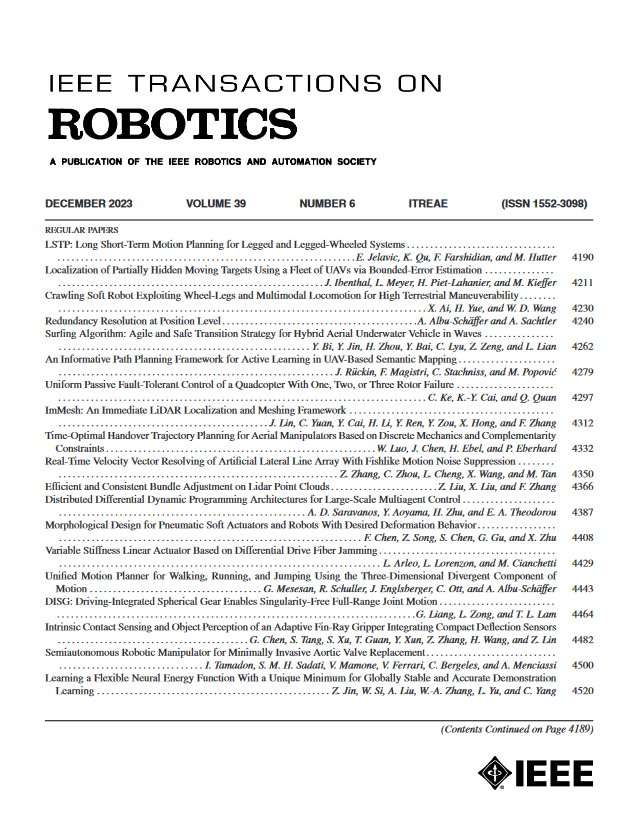ELSA:一个一英尺大小的动力假肢,在各种运动任务中再现脚踝的动态
IF 10.5
1区 计算机科学
Q1 ROBOTICS
引用次数: 0
摘要
动力踝足假体提供了模仿自然运动动力学的潜力,从而解决了与步态不均匀和动力不足相关的问题,这些问题通常是由佩戴被动假肢装置的下肢截肢患者经历的。尽管取得了重大进展,但现有的动力假肢往往受到其庞大的建造高度,笨重的设计,过重的重量和噪音水平的阻碍,限制了它们的广泛采用。这项工作展示了高效轻便的弹簧踝关节,轻巧(1.15公斤)和紧凑(11厘米高)的动力踝关节-足假体,安装在鞋子的体积内,能够在步态周期内提供净正机械能。这种水平的集成是通过一个创新的安排,一个弹簧和执行机构的协同作用来实现的。这种混合结构为用户提供了积极行走的选择,并提供了推进能源辅助;可再生,潜在地允许能量收集为设备电池充电;或者完全关闭(被动)。这个原型已经在台式实验和四个截肢参与者的试验中得到了验证。这些测试包括各种场景,包括跑步机行走和日常行走任务。此外,还进行了灵敏度分析,以评估不同控制参数对提供的机械能和步态性能的影响。本文章由计算机程序翻译,如有差异,请以英文原文为准。
ELSA: A Foot-Size Powered Prosthesis Reproducing Ankle Dynamics During Various Locomotion Tasks
Powered ankle–foot prostheses offer the potential to emulate natural locomotion dynamics, thereby addressing the issues related to uneven gait and insufficient propulsion typically experienced by individuals with lower limb amputation wearing a passive prosthetic device. Despite significant progress, existing powered prostheses are often hindered by their substantial build height, bulky design, excessive weight, and noise level, limiting their widespread adoption. This work presents efficient and lightweight spring ankle, a lightweight (1.15 kg) and compact (11 cm high) powered ankle–foot prosthesis fitting within the volume of a shoe and capable of providing a net positive mechanical energy over the gait cycle. This level of integration is achieved through an innovative arrangement of a spring and actuator mechanisms operating in synergy. This hybrid architecture offers users the choice to walk actively, with propulsive energy assistance; regeneratively, potentially allowing for energy harvesting to recharge the device battery; or completely turned
off
(passive). This prototype has been validated during benchtop experiments and through trials involving four amputated participants. These tests encompassed various scenarios, including treadmill walking and everyday ambulation tasks. In addition, a sensitivity analysis was conducted to assess how different control parameters impacted the provided mechanical energy and resulting gait performance.
求助全文
通过发布文献求助,成功后即可免费获取论文全文。
去求助
来源期刊

IEEE Transactions on Robotics
工程技术-机器人学
CiteScore
14.90
自引率
5.10%
发文量
259
审稿时长
6.0 months
期刊介绍:
The IEEE Transactions on Robotics (T-RO) is dedicated to publishing fundamental papers covering all facets of robotics, drawing on interdisciplinary approaches from computer science, control systems, electrical engineering, mathematics, mechanical engineering, and beyond. From industrial applications to service and personal assistants, surgical operations to space, underwater, and remote exploration, robots and intelligent machines play pivotal roles across various domains, including entertainment, safety, search and rescue, military applications, agriculture, and intelligent vehicles.
Special emphasis is placed on intelligent machines and systems designed for unstructured environments, where a significant portion of the environment remains unknown and beyond direct sensing or control.
 求助内容:
求助内容: 应助结果提醒方式:
应助结果提醒方式:


